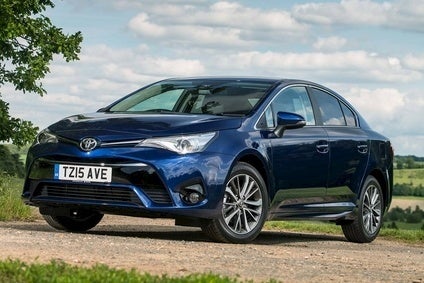
It’s a conundrum for Toyota Motor Europe – how to justify staying in the declining D segment? Volkswagen, Opel-Vauxhall and Ford leverage their rival models across global markets and/or multiple brands but the Avensis is more or less a Europe-only car.
The answer to the question is the latest, heavily facelifted model. This is now a seven-year old car, which is ancient by Toyota’s usual worldwide standards, though let’s exclude vehicles such as the 31 years young 70 Series Land Cruiser from that rule.
To give the Avensis the boost it needed, TMC struck a deal with BMW Group. This expanding cooperation will see the firms produce co-developed sports cars in a year or so, shared fuel cell tech later in the decade, and access for Toyota Motor Europe to 1.6- and 2.0-litre TwinPower BMW diesel engines.
The 1,598cc unit in the test car proved to be quiet at idle and very smooth no matter how hard it was revved. The six-speed manual gearbox wouldn’t have been my personal choice but that’s not to say it was in any way unsatisfactory, just that with the inevitable jams anyone in the south of England lives with, automatic is the way to go.
The car’s latest update does a good job of disguising just how old the Avensis is. The front end sees the largest amount of change: the restyle at this end is especially curvy and looks contemporary. The nose is long but compared to the pre-facelift model, you now tend not to notice it. That’s due to the way the bonnet, grille, bumper, valance and headlights are allied to form a long and rounded shape, with the DRL flowing into the grille. The rear end has had less dramatic changes yet it too looks different enough to make buyers believe that this could be a new model, not just a refresh.
The age of the Avensis is more obvious from the inside but nonetheless, it’s not badly dated, just somewhat less than exciting or imaginative. Typically Toyota in so many ways – everything looks and feels as though it has been designed to last for 30 or maybe even 40 years, just like the Corollas, Carina Es, Celicas and Estimas that you still see on British roads.

US Tariffs are shifting - will you react or anticipate?
Don’t let policy changes catch you off guard. Stay proactive with real-time data and expert analysis.
By GlobalDataGraeme gave us an update on the manufacturing side of things as regards not only the Avensis, but also the Auris, during the summer. That was at the time when the plant which builds both cars, and on the same line, was switching over to the revised versions.
Back in September, Dave told us that the Burnaston plant in Derbyshire should produce about 35,000 units of this model in 2015. With the way that buyer preferences have gone, the majority of these will be estates. I tested the saloon but across Europe as a whole, wagons made up around 60% of sales in this segment. By contrast, back in 2000, the figure was only 30%, research undertaken by IHS notes. The leader in this class is of course the Passat and in Germany, Italy and Sweden, almost 90% of the car’s registrations are wagons. That explains why in a couple of EU markets, the Avensis sedan isn’t even available.
To drive, this feels like the outgoing Kia Optima: smooth, quiet, steady. You would call this a ‘nice’ car and it’s easy to see why the Avensis is a favourite of people who own and operate taxis. This is not a vehicle you’d ever expect to see broken down, and the interior will be extremely hard wearing.
A few things which wouldn’t stop you buying the car, but they’re worth mentioning: the boot lid clangs when closed, though so does the GT86’s; the button you must push to start the car occasionally needs a second push; and the parking brake button is awkwardly placed under and to the left of the steering wheel. I know – that’s all I could find to be not quite irritated by, which says a lot about how pleasing this model will be to its owners. And me even mentioning the parking brake position isn’t really relevant anyway as it’s applied/deactivated automatically.
Toyota is holding steady in its UK sales, with the latest figures available at the time of writing showing a total of 81,604 passenger cars sold during the first nine months. That represents a 7.3% gain, with the market up by 7.08%. The revised Avensis isn’t going to set the sales charts alight, but with the revised Auris also now on sale, October should have been a strong month. A new Hilux is also entering showrooms right now, while the facelifted RAV4 and its new hybrid derivative will be on the market in December and February respectively. Then comes the new Prius (likely for April), a Juke-sized crossover for the summer (Geneva debut in March), probably a facelifted GT86 and new Land Cruiser also around mid-year, and the next generation Yaris towards the end of 2016.


